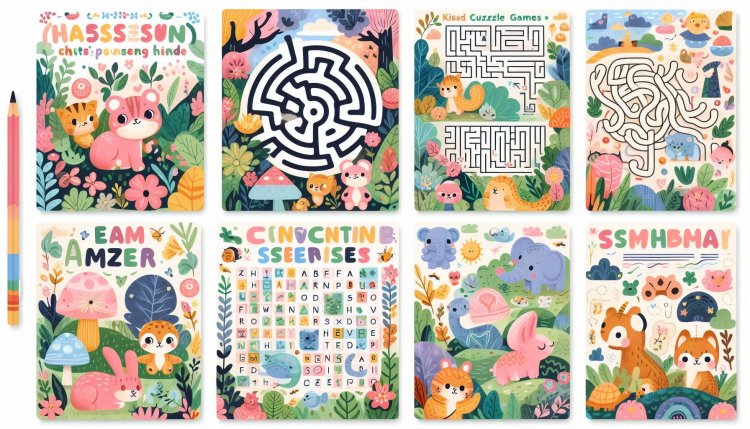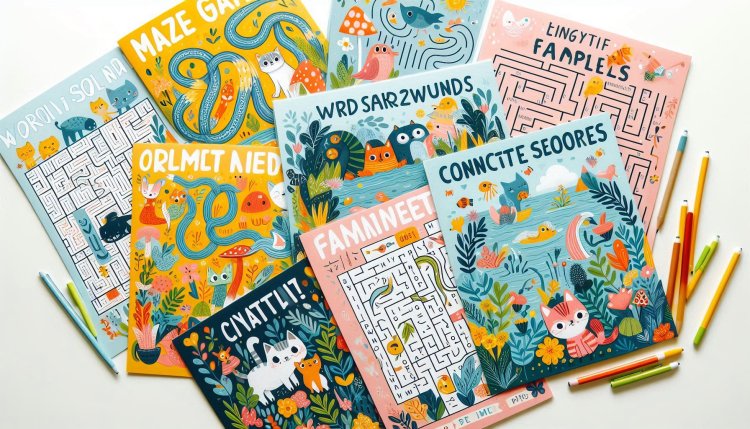Puzzle Games for Kids on Paper: Fun, Screen-Free Activities to Boost Creativity and Problem-
In a world dominated by screens, finding engaging, screen-free activities for kids can be a challenge. Puzzle games on paper are a fantastic solution, offering endless entertainment while promoting critical thinking, creativity, and fine motor skills. From classic mazes to innovative DIY puzzles, these activities are perfect for home, school, or travel.
Introduction
In a world dominated by screens, finding engaging, screen-free activities for kids can be a challenge. Puzzle games on paper are a fantastic solution, offering endless entertainment while promoting critical thinking, creativity, and fine motor skills. From classic mazes to innovative DIY puzzles, these activities are perfect for home, school, or travel. In this guide, we’ll explore the best puzzle games for kids on paper, along with step-by-step instructions to create them. Let’s dive into the world of paper-based fun!
Why Choose Puzzle Games on Paper?
Paper puzzles are more than just a way to keep kids busy—they’re educational tools that offer numerous benefits:
-
Cognitive Development: Enhances problem-solving and logical thinking.
-
Creativity: Encourages kids to think outside the box.
-
Fine Motor Skills: Improves handwriting and hand-eye coordination.
-
Screen-Free Fun: Provides a break from digital devices.
-
Affordability: Requires only paper and a pencil, making it budget-friendly.

Top Puzzle Games for Kids on Paper
1. Mazes
Mazes are a timeless favorite that challenge kids to find their way from start to finish.
How to Create a Maze:
-
Draw a grid on a piece of paper.
-
Design pathways and dead ends using lines.
-
Mark the start and finish points.
-
Add themes like animals, space, or treasure hunts to make it more engaging.
Why Kids Love It: Mazes are visually stimulating and offer a sense of accomplishment when solved.
2. Word Searches
Word searches are excellent for building vocabulary and improving spelling.
How to Create a Word Search:
-
Draw a grid (e.g., 10x10 or 15x15).
-
Write a list of words to hide in the grid.
-
Fill in the words horizontally, vertically, or diagonally.
-
Add random letters to the remaining spaces.
Why Kids Love It: It’s like a treasure hunt for words!
3. Crossword Puzzles
Crosswords are perfect for older kids who enjoy a challenge.
How to Create a Crossword Puzzle:
-
Draw a grid and number the starting cells of each word.
-
Write clues for “Across” and “Down” words.
-
Fill in the answers and ensure they intersect correctly.
Why Kids Love It: It combines vocabulary-building with problem-solving.
4. Spot the Difference
This visual puzzle game sharpens observation skills.
How to Create Spot the Difference:
-
Draw two nearly identical pictures side by side.
-
Make subtle changes to one image (e.g., add or remove objects).
-
Ask kids to circle the differences.
Why Kids Love It: It’s a fun way to test their attention to detail.
5. Tangrams
Tangrams are geometric puzzles that involve arranging shapes to form a specific design.
How to Create Tangrams:
-
Cut a square piece of paper into seven pieces: five triangles, one square, and one parallelogram.
-
Provide kids with silhouette outlines to recreate using the pieces.
Why Kids Love It: It’s a hands-on activity that combines art and math.
6. Dot-to-Dot Puzzles
Dot-to-dot puzzles are great for younger kids learning numbers or letters.
How to Create Dot-to-Dot Puzzles:
-
Draw a series of numbered dots in the shape of an object or animal.
-
Kids connect the dots in order to reveal the hidden image.
Why Kids Love It: It’s exciting to see the picture come to life.
7. Sudoku for Kids
Sudoku puzzles adapted for kids use simpler grids and symbols instead of numbers.
How to Create Sudoku for Kids:
-
Draw a 4x4 or 6x6 grid.
-
Fill in some cells with numbers, letters, or symbols.
-
Ensure each row, column, and smaller square contains all the symbols without repetition.
Why Kids Love It: It’s a fun introduction to logic puzzles.
8. Hidden Pictures
Hidden picture puzzles involve finding objects concealed within a larger scene.
How to Create Hidden Pictures:
-
Draw a detailed scene (e.g., a forest or a classroom).
-
Hide small objects within the drawing.
-
Provide a list of items for kids to find.
Why Kids Love It: It’s like a scavenger hunt on paper.
How to Make Puzzle Games More Engaging
-
Add Themes: Use your child’s favorite characters, animals, or hobbies.
-
Incorporate Rewards: Offer small prizes for completing puzzles.
-
Make It Collaborative: Create puzzles for siblings or friends to solve together.
-
Personalize It: Include your child’s name or inside jokes in the puzzles.
Educational Benefits of Paper Puzzle Games
-
Problem-Solving Skills: Kids learn to think critically and strategize.
-
Patience and Persistence: Puzzles teach the value of patience and not giving up.
-
Language Development: Word-based puzzles expand vocabulary and spelling.
-
Math Skills: Tangrams and Sudoku introduce basic math concepts.
-
Creativity: Designing and solving puzzles fosters imagination.
Tips for Creating Puzzle Games on Paper
-
Start Simple: Begin with easy puzzles and gradually increase the difficulty.
-
Use Templates: Find printable templates online for inspiration.
-
Involve Kids: Let them help design the puzzles for added fun.
-
Keep It Fun: Avoid making puzzles too challenging or frustrating.

Printable vs. DIY Puzzles
-
Printable Puzzles: Great for convenience and variety. Websites like Pinterest offer free templates.
-
DIY Puzzles: Allow for customization and creativity. Kids can even design their own puzzles to share with friends.
Conclusion
Puzzle games for kids on paper are a timeless way to entertain, educate, and inspire. Whether it’s a maze, word search, or tangram, these activities provide hours of screen-free fun while nurturing essential skills. With a little creativity and some basic materials, you can create endless puzzles that your kids will love.
What's Your Reaction?

















.png)






.jpg)
